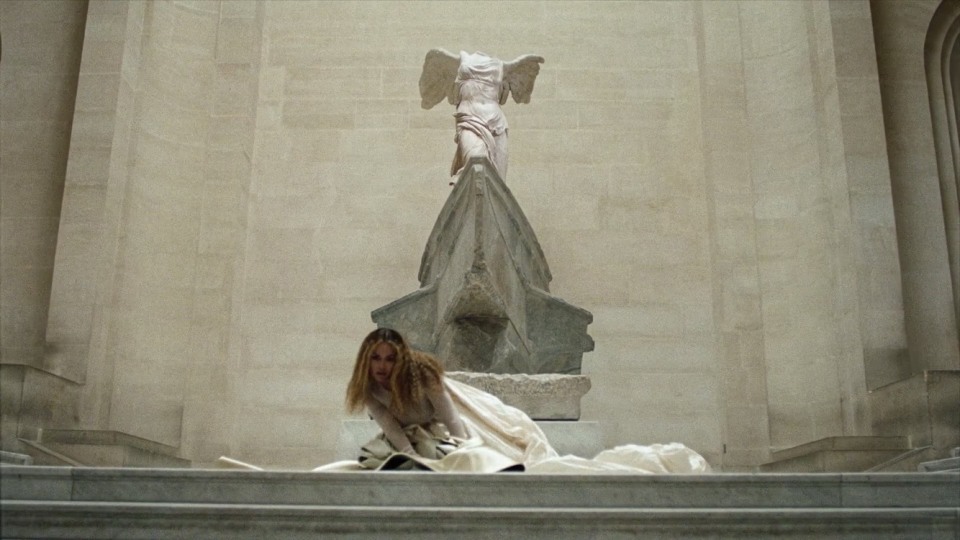APESH*T by THE CARTERS

In the music video APESH*T by The Carters, Beyoncé and Jay-Z use their bodies to develop a more powerful, emotional, and meaningful aesthetic communication of the song’s lyrics. Through the song and video, the artists comment on racial and gender dynamics, affirming their resilience and strength despite past and current discrimination. With the Louvre serving as a backdrop for this rap-heavy, almost trap music song, the two black artists claim their space in a museum filled with works of art both by and depicting white men and women. The video is beautifully shot, and throughout the song the artists and dancers create a new, significant relationship to the wonderful artworks found in this paramount institution.
Nevertheless, there is almost a disregard for the art, and the cast of the video posit themselves as the works of art themselves. In one of the opening scenes, The Winged Victory of Samothrace, a Greek statue of the goddess Nike, serves as an “accessory” behind Beyoncé. Covered in layers of white fabric, Beyoncé dances before the marble goddess, mimicking the movement of wings. Beyoncé becomes the true center of attention and she completely overtakes the statue, transforming into the actual goddess in the shot. The dancers laying on the stairs below move in a pulse-like manner, and their formation reminds viewers of a spine like structure holding up the Carters’ dominion.
The Sphinx, which is the only African artwork in the entire video, gets a different form of attention and treatment. The work does not fade into the background, but it is brightly lit. You cannot easily make out Beyoncé and Jay-Z’s faces, and they are positioned in front of the Sphinx almost as if protecting it. The artists are attempting to re-narrativize the notion that art from Ancient Egypt is often separated from African and black art and instead joined with ancient Greek and Roman art. Beyoncé and Jay-Z use this artwork to connect to their African past and push forward a notion of power, transformation, and resilience.
Portrait of a Black Woman (Negress) (1800) by Marie-Guillemine Benoist, is the sole painting of a black women presented in the music video. Although black bodies have often been included in Western Art, The Carters highlight how black culture and practices have instead been ostracized or unwelcomed. In this painting, the black woman’s breasts are exposed and she is hyper-sexualized. Beyoncé and Jay-Z essentially intervene in this narrative by instead only showing the face of the black woman in the painting and cutting out the part of the artwork displaying her breasts. They attempt to disrupt this sexualization and instead impart power and respect to the depicted African American woman.
Beyoncé pushes back on the notion of “lady like” behavior, as she raps, curses, and sings lyrics such as, “Get off my d*ck.” She and Jay-Z are presented as equals, they are “The Carters,” no longer just Beyoncé and Jay-Z. Jay-Z stands in the frame as Beyoncé raps and steals the spotlight. The men and women in the video also show a fluid approach to gender, as the men move around gracefully, while the women are more aggressive and empowered. In one of the shots, a black couple kissing and holding one another is juxtaposed with a painting of Francesca and Paolo from Dante’s Inferno. While in the painting the woman is clinging onto the man in despair, in the contemporary scene the woman is cradling and comforting the man as he gently rests his face on her chest. The “real” moment of intimacy ignites a much more significant response, as viewers are left wondering about their struggles, their lives, and their circumstances.
In another shot, Beyoncé dances in front of the painting The Consecration of the Emperor Napoleon and the Coronation of the Empress Josephine by Jean-Luis David (1804). Beyoncé stands right below the crown, and this purposeful positioning is meant to convey that she is now the one being crowned queen. She dances in front of the painting with a group of black women robed in tight, nude clothing. The shot empowers black feminists and juxtaposed with this Western artwork of white monarchical domination, Beyoncé and the dancers reclaim their authority and unveil themselves as the modern royalty.
In the closing scene, a young woman is gently brushing through a man’s afro as they stand in front of the Mona Lisa. This careful placement and aesthetic choice were meant to impart to black culture the same importance that our society gives to the Mona Lisa. The scene references the work of black artist and photographer Carrie Mae Weems. However, this intimate moment is removed from familiar surroundings and instead placed in a distinguished public space. The two individuals stand incredibly close to the painting, but once again the work of art, the Mona Lisa,is merely a backdrop for this warm and personable occurrence that is profoundly traditional to Black culture.













